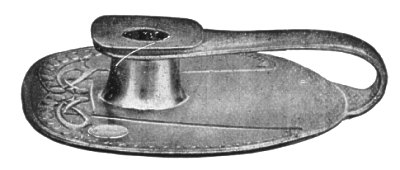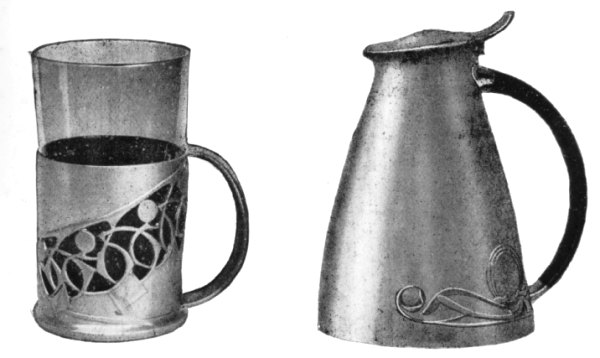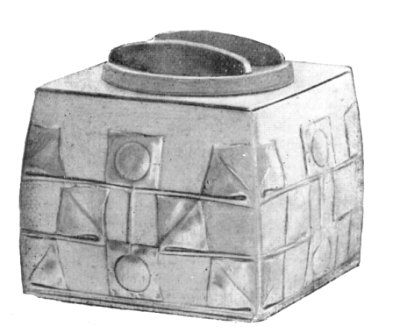[From Mannin #7, 1916]
Archibald Knox
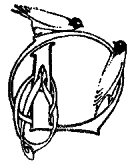 ESIGNER,
watercolour painter, and art master, born in Douglas; lived there, within sight
of the sea, for thirty-three years, working and studying art traditions and
the colour of the Island's shores and clouds, creating thus a style, complete
in itself, his own and none other. There are few who give their whole force
to the developing of the Spirit which is Art; those who do leave their work
to be the milestones on the Road.
ESIGNER,
watercolour painter, and art master, born in Douglas; lived there, within sight
of the sea, for thirty-three years, working and studying art traditions and
the colour of the Island's shores and clouds, creating thus a style, complete
in itself, his own and none other. There are few who give their whole force
to the developing of the Spirit which is Art; those who do leave their work
to be the milestones on the Road.
You of the Island can write of Mr.
Knox's early work, I only know the result of it. He came to us in
England to teach in three art schools of Surrey: Kingston, Wimbledon,
and Redhill, and also to design for Liberty's. We students had seen
Mr. Knox's work at exhibitions, but as Design Master we first met
him.
The first morning, as many mornings afterwards, he came into the
art school room in spotless linen and Manx grey tweed, smiling, and
saying 'Good morning to you' — we did not know then that that
was Manx manner of words. Passing from one student to another,
illustrating and explaining, Mr. Knox spoke only to help. Cistercian
almost in his silence, expressing with a few strokes of his pencil
more than many masters could by half-an-hour's talk. It was always a
sorrow to us when his blackboard drawings had to be rubbed out. The
last drawing on the board before he left England was a perfectly
drawn anvil — drawn for a student who was making a composition.
For many weeks that drawing remained regarded as a symbol of
work.
Mr. Knox's system of teaching was essentially his own. Instead of
insisting on the English method of art education by making laborious
copies of scraps of museum specimens of 'styles' he made at his own
expense three thousand lantern slides, illustrating works of art from
prehistoric times down to the gipsy caravans of to-day, showing how
Art was produced by the workman in the joy of using his chisel or
hammer. To you of MANNIN it will be interesting to know that he gave
lectures on your grey thatched homes, your churches, and your
crosses, making us love them as if they were our own.
Many of the lectures were divided into groups, such as colour,
windows, pot contours, etc. Comparing one example with another Mr.
Knox would show which had the greatest thought in it, which was most
suited to its purpose and the material used — teaching that
there were two Natures, Outside Nature and Our Own, the last being
Art, Art the outcome, or the reward of practice and study. Style or
Art came to the artist as to the musician, only after long and
continual application to the paintbox or the keyboard, application
with resolution and thought. Not until this Self Nature was expressed
was the work produced complete, distinctive by its individuality,
glowing as a stone mined from the recesses of the unknown.
Whenever anything is said about individuality and modern art, the
art critics (there are always some about) fly up and say 'Oh, we
don't want anything extraordinary,' forgetting that there can be new
good and simple things that represent the thought of a modern mind.
When Mr. Knox gave up teaching in England, there were many to miss
his helping hand, and twenty of his students banded together and
formed The Knox Guild of Design and Crafts. The main object of the
Guild is to carry out Mr. Knox's teachings, and to encourage by
public exhibitions and craft demonstrations a wider public interest
in the design of personal and household belongings. These exhibitions
have created much interest and have attracted hundreds of people.
To designers it will be interesting to know that Mr. Knox has
discovered the principle upon which counterchanges are formed, and
has written a book upon the subject and made some hundreds of
illustrations, but unfortunately has not tried to get it
published.
For Liberty's, the art shop of Regent Street, Mr. Knox made over four hundred
designs. One of their directors recently said 'We have never had anyone to work
for us like Mr. Knox.' No doubt Mr. Knox s influence has done much to help make
Liberty's name famous for colour, pewter, and jewellery work. A series of designs
for pewter for table use for this firm established a new era in pewter design;
some of these pieces of work exhibit the simplicity and the style of Mr. Knox's
design as well perhaps as any of his work — the perfect contour of the
form, the strong 'spiritual' curves of the interlacing, show the depth of thought
that must have been given before objects so complete could have been evolved.
|
|
|
|
|
|
|
|
|
Pewter Designs - A Knox
by kind permission of Liberty & Co.
|
The illustration shows a coffee set, one of the pewter series of
designs. Many are the reproductions of this set that have been made.
It is to be hoped that one will find its way into a museum to be kept
as an example of twentieth century design. The jewellery designs are
many, being principally of interlaced forms set with moonstones,
opals, and other stones, their charm being — in their harmony
of line and change of surface, Celtic in their simplicity, altogether
different from anything designed before.
Many of you may know Mr. Knox's illuminated parchments, worthy
descendants of the work of the early artists of the west, delicately
coloured scripts, containing the qualities of the old work with
modern feeling in treatment and form. A number of addresses designed
by Mr. Knox remain in Surrey, presented by the Borough of Kingston
upon Thames.
As T. E. Brown has given the poetry of your people, so has Mr.
Knox given in watercolour the poetry of your skies, shores, and
buildings, painted your boats, trees, and bridges, flecked with
sunlight and shade as no other man has painted them. If you built a
gallery for his work in the centre of your Isle, future generations
would bless your name.
To you who possess work by Mr. Knox I say treasure it, and leave
it to your Island, that your children's children may learn from it,
and produce perhaps, yet greater work.
W. T.
[Winifred Tuckfield — one of founders of Knox Guild
of Craft and Design]
|

Castletown Harbour
|
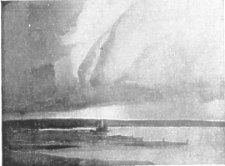
On the Lincolnshire coast |
From water colours by A Knox
 ESIGNER,
watercolour painter, and art master, born in Douglas; lived there, within sight
of the sea, for thirty-three years, working and studying art traditions and
the colour of the Island's shores and clouds, creating thus a style, complete
in itself, his own and none other. There are few who give their whole force
to the developing of the Spirit which is Art; those who do leave their work
to be the milestones on the Road.
ESIGNER,
watercolour painter, and art master, born in Douglas; lived there, within sight
of the sea, for thirty-three years, working and studying art traditions and
the colour of the Island's shores and clouds, creating thus a style, complete
in itself, his own and none other. There are few who give their whole force
to the developing of the Spirit which is Art; those who do leave their work
to be the milestones on the Road.